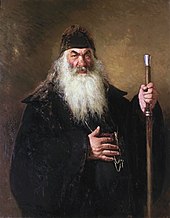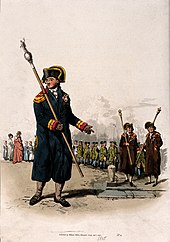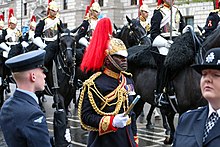
A staff of office is a staff, the carrying of which often denotes an official's position, a social rank or a degree of social prestige.
Apart from the ecclesiastical and ceremonial usages mentioned below, there are less formal usages. A gold- or silver-topped cane can express social standing (or dandyism). Teachers or prefects in schools traditionally carried less elaborate canes which marked their right (and potential threat) to administer canings, and military officers carry a residual threat of physical punishment in their swagger sticks. Orchestral conductors have in their batons symbols of authority as well as tools of their trade.
Ecclesiastical use

Churchwardens (and sometimes sidesmen) traditionally carry staves or wands on special occasions as an emblem of their office.
In the Eastern Orthodox Church and some of the Oriental Orthodox Churches an ecclesiastical walking stick is used by bishops, archimandrites and hegumens (abbots) when walking outside. It is usually made of dark wood and is straight, rather than having a curved handle. The walking stick used by bishops and archimandrites is normally adorned with a silver grip at the top and a metal ferrule at the tip. The walking stick used by a hegumen or hegumenia (abbess) is normally of plain wood, unadorned. The walking stick is not used in any liturgical context, except to the extent that when a bishop is formally received at the beginning of the service, he will carry it as he walks into the church. An altar server will usually take it from him when he enters the narthex and return it to him when he leaves at the end of the service.
Western bishops may use a crozier or crook in a liturgical setting as a symbol of their pastoral authority.
State and ceremonial use
Monarchs often have a rod or sceptre signifying their office, and field-marshals are traditionally given a short thick baton in several countries. There are also offices which take their titles from their staff, such as Black Rod, the Tipstaff, Gold Stick and Silver Stick.
White staves

A thin white staff or "wand" is the traditional emblem of certain Great Officers of State and high-ranking officials of the Royal Household in the United Kingdom, namely:
Great Officers of State:
Senior Officers of the Household:
- The Lord Steward
- The Lord Chamberlain
- Treasurer of the Household
- Comptroller of the Household
- Vice-Chamberlain of the Household
The "wand", which is around 5 feet 6 inches (1.68 m) in length, is made of white wood and has a silver plate at its base on which is engraved the name of the office to which it pertains. The wands are carried by their holders when on duty on state or other royal occasions, such as state banquets, jubilee services and royal weddings, as well as at the State Opening of Parliament (when the Lord Great Chamberlain raises his white staff to signal to the king's messenger, Black Rod, to summon the Commons).
Apart from the Lord High Steward (an office which is only now filled for coronations), all the above-listed officials were seen carrying their white staves during the State funeral of Queen Elizabeth II. The Lord Chamberlain, as executive head of the Royal Household, ceremonially breaks his white staff at the monarch's state funeral, when he automatically loses office; it is then buried with the sovereign. This was publicly observed at the committal service of Elizabeth II on 19 September 2022 (the first time such a service had been filmed or televised), when the incumbent, Lord Parker of Minsmere, performed this duty. The ritual, sometimes referred to as the "breaking of the stick", goes back many centuries (at one time all the officers of the Household who carried white staves would break them at this point and throw them into the grave, but since the 18th century the Lord Chamberlain alone has done so). The staff used to be physically broken, but in modern time it is jointed in the middle and the two halves can be separated.
The Lords with White Staves (namely the Lord Steward and Lord Chamberlain) are traditionally responsible for presenting addresses from the House of Lords to the Sovereign, and then delivering the Sovereign's response to the House. The Vice-Chamberlain of the Household today fulfils a similar role with regard to the House of Commons.
A queen consort traditionally has a separate Household, headed by her own Lord Chamberlain, who is likewise invested with a white staff. Following the funeral of Queen Elizabeth The Queen Mother in 2002, her Lord Chamberlain (the Earl of Crawford and Balcarres) attended the private interment service and likewise broke his white staff in two over her coffin.
Other state and ceremonial officers

The Earl Marshal and the Lord High Constable carry batons as their insignia when on duty, reflecting the military origins of those offices.
Garter King-of-Arms has carried a gold or silver rod on state occasions since 1522. In 1906 the other officers of arms were similarly each provided with a gold-mounted ebony baton, decorated with their individual badge of office; in 1953 these were replaced with white staves, topped with a blue dove within a gold coronet.
On great occasions of state the Earl Marshal may appoint officers to assist in the marshalling of processions and other duties; they are provided with a wooden staff of office as a symbol of their authority, the colour of which varies depending on the occasion: reflecting this, those on duty at Coronations are known as Gold Staff Officers, those on duty at State Funerals Purple Staff Officers, and in 1911 and 1969 those on duty at the Investiture of the Prince of Wales were termed Green Staff Officers.
See also
References
- Meakin, Tony (2001). A Basic Church Dictionary. Norwich: Canterbury Press. p. 81.
- "Section 13.04 Ecclesiastical style of dress". Governance and Canon. Inclusive Orthodox Church. Retrieved 10 October 2010.
may carry a walking stick ...
- Hastings, James (1921). Encyclopædia of Religion and Ethics: A-Art: Index. C. Scribner's sons. p. 813. ISBN 9780567065094.
- Norris, Herbert (January 2002). Church Vestments: Their Origin and Development. p. 116. ISBN 9780486422565.
- ^ Churchill, Randolph Spencer (1953). They Serve the Queen: A New and Authoritative Account of the Royal Household. London: Hutchinson & Co. p. 13.
- Liversidge, Douglas (1976). The House of Lords. London: Franklin Watts. p. 88.
- "Your complete guide to the Queen's funeral". BBC News. 19 September 2022. Retrieved 20 September 2022.
- Bulbul, Nuray (19 September 2022). "What is the Wand of Office that will be broken when the Queen is laid to rest?". Evening Standard. Retrieved 20 September 2022.
- "Explained: What is the 'Wand of Office' and why will it be broken for the Queen". The Independent. 20 September 2022. Retrieved 20 September 2022.
- "What was the 'wand of office' broken at the Queen's funeral?". the Guardian. 19 September 2022. Retrieved 20 September 2022.
- Bland, Olivia (1986). The Royal Way of Death. London: Constable.
- Erskine May, Sir Thomas (1879). A Treatise on the Law, Privileges, Proceedings and Usage of Parliament (8th ed.). London: Butterworths. p. 471.
- ^ Allison, Ronald; Riddell, Sarah, eds. (1991). The Royal Encyclopedia. London: Macmillan. p. 576.
- "Lord Chamberlain" . Encyclopædia Britannica. Vol. 17 (11th ed.). 1911. pp. 1–2.
- "Queen says a private farewell to her mother". The Age. 11 April 2002. Retrieved 28 September 2022.
- Mansfield, Alan (1980). Ceremonial Costume. London: A & C Black. pp. 191–201.